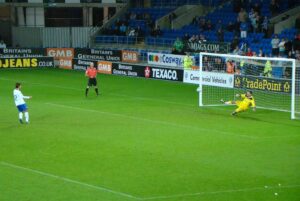Photo by Flickr, CC by 2.0
Video Assistant Referee (VAR) technology remains a source of confusion and debate even though it has been around for quite some time now.
In the Premier League, the VAR’s role is strictly limited to correcting “clear and obvious errors” or identifying “serious missed incidents.”
From their base at Stockley Park in London, trained officials monitor live footage and can intervene in four key areas: goals, penalties, direct red cards, and cases of mistaken identity.
In most situations, the on-field referee is encouraged to consult the pitch-side monitor before making a final call—except in offside decisions, which are handled solely by the VAR team.
VAR in control of offside corrections
Here, there’s no room for debate with the referee on the ground. The VAR can overrule the original decision if a mistake has been made regarding offside, however marginal.
In the Premier League’s words, offsides are “factual decisions”; there’s no grey area. Yet, offside reviews have perhaps sparked more controversy in the VAR era than any other due to how marginal they can be.
A still image is used to determine whether a player is on or offside, and lines are drawn by the VAR official to work out the correct decision. The lines have gone through a couple of stages of evolution since VAR was introduced to the Premier League in 2019/20 and remain a work in progress.
Dotted lines gone but not forgotten
Currently, there are two levels of line usage for offside decisions at the Premier League level. The first is a two-dimensional gridline, placed in line with the final defender to determine routine offside decisions.
But if the naked eye can’t determine whether a player is onside from the use of a gridline, then crosshairs are implemented.
On the image officials are using, one-pixel dotted lines are manually drawn against the leading body part of the last defender and attack that can score goals. From there, the VAR clicks a confirm button on his computer, and a red or green line will appear to make the final decision.
This whole process used to be broadcast for televised games but left some fans confused and has since been simplified. As of the 2021/22 season, now all the viewing fans get to see is the final image with the green or red line, which is still more than those at the ground are treated to.
Automation to remove human error
The Premier League has increased the thickness of the lines to try and eliminate the really marginal calls where a player’s toe has strayed beyond the last defender.
The process has improved and been made less confusing, but officials and teams are pushing for more to be done.
Semi-automated technology for offside calls was used at the 2022 World Cup to eliminate human error and speed up the decision-making process, which can take minutes for close calls.
There’s no need to draw lines with semi-automated offsides, reducing the risk of human error, which has been a factor in certain games this season.
The Premier League has introduced semi-automated offsides in the 2024/25 season before a move to fully automated offsides. That is still a few years away, but the drawing of lines may not be much longer for English football’s top flight if the clubs get their way.
When VAR got it wrong
PGMOL reports that VAR was responsible for correcting more than 100 officiating errors throughout the 2024/25 Premier League campaign. However, VAR remains a gradually improving technology and there were some cases in the past when the VAR made some costly mistakes.
Arsenal were left fuming in February 2023 when the VAR “forgot” to draw lines for Brentford’s equaliser in the Gunners’ 1-1 draw with the Bees. That was the same day Brighton had a goal wrongly ruled out for offside against Aston Villa.
Luis Díaz appeared to give Liverpool a 1-0 lead against Tottenham on 23 September 2023 with a surging run from the halfway line, but the goal was wrongfully ruled out because of offside.
"The goal by Luis Díaz was disallowed for offside by the on field team of match officials. This was a clear and obvious factual error."@richardajkeys and Andy Gray react to the PGMOL statement on the mistake made in flagging Luis Díaz offside today. #beINPL #TOTLIV pic.twitter.com/O7CIf3tM2G
— beIN SPORTS (@beINSPORTS_EN) September 30, 2023
On the pitch, Simon Hooper disallowed the goal. In the booth, VAR Darren England didn’t intervene—wrongly thinking the referee had allowed it to stand. By the time the mix-up was realised, the game had restarted and the chance to correct it was lost. Liverpool were denied, and Tottenham capitalised with a late, decisive strike.
Yes, Ouattara's goal for Bournemouth against Newcastle should have stood after the ball came off the top of the arm which by their laws is not a handball, disgraceful decision which has cost Iraola's side 2 points pic.twitter.com/18cLIVFGvn
— Has the Referee or VAR made a poor decision? (@PoorEPLreferees) August 25, 2024
On 25 August 2024, Bournemouth’s Dango Ouattara saw a dramatic 92nd-minute winner against Newcastle controversially disallowed for handball, prompting Bournemouth manager Andoni Iraola to admit: “It’s the most frustrated I’ve been on a touchline”.




